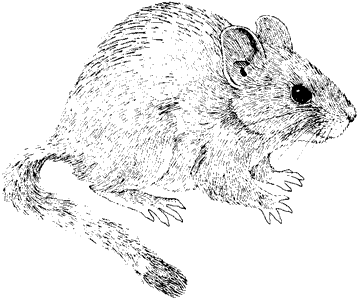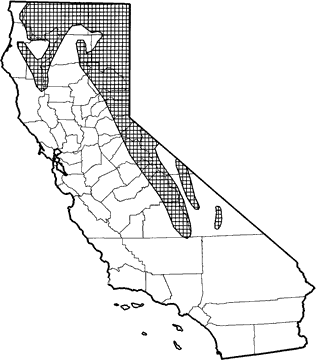
Bushy-tailed Woodrat
Distribution, Abundance, and Seasonality
In California, occurs from the Oregon border in Siskiyou Co. south through the Trinity Mts. (central and eastern Trinity Co. to western Shasta and Tehama cos.), and from Modoc Co. south through the Sierra Nevada to southern Tulare Co. Optimal habitats are rock outcrops associated with coniferous forests, montane riparian, montane chaparral, and alpine dwarf-shrub. Common to abundant in valley-foothill hardwood, hardwood-conifer, and riparian habitats. Other preferred habitats include montane hardwood-conifer, Douglas-fir, redwood, red fir, Jeffrey pine, and subalpine conifer. Uncommon to common in a variety of other habitats. Distribution and abundance seem to be limited largely by availability of shelter.

Range Map
Specific Habitat Requirements
Feeding: Gathers foliage, fruits, seeds, bark, insects, and fungi from ground, in shrubs, and less commonly, in trees (Finley 1958). Aspen, dogwood, alder, coffeeberry, and bitter cherry leaves may be stored for winter use in rock crevices and dens in late August to September (Escherich 1981).
Cover: Dens are used to escape predators, although N. cinerea also climbs trees well. Mine tunnels and deserted buildings also common as den sites.
Reproduction: Dens of sticks, foliage, and miscellaneous debris are built at entrance to crevice, in caves, and in forks of trees (Hall 1946). Bushy-tailed woodrats usually construct loose, sloppy nests, not the compact conical lodges characteristic of the dusky-footed woodrat (Maser et al. 1981). Nests made of dried foliage and sticks are constructed within the den. In Oregon, nests have been found more than 50 ft above the ground (Maser 1965b,1966).
Water: Captive animals drink water. In the wild they apparently glean enough moisture from food so they seldom need to drink.
Pattern: Rock outcrops, mine tunnels, or other rock areas (e.g., talus slopes, lava rims) seem to be required (Escherich 1981).
Species Life History
Activity Patterns: Nocturnal. Active year-round.
Seasonal Movements / Migration: None.
Home Range: Activity is heavily concentrated in vicinity of den (Escherich 1981).
Territory: Same as home range. Territory is marked with urine or with a gland secretion, forming characteristic white patches on rocks. Males are extremely agonistic toward other males. Females may fight, but without the intensity seen in males (Escherich 1981).
Reproduction: Breeds from April into August. Apparently polygynous, with dominant male maintaining a harem of 2-3 females. Seasonally polyestrous. Gestation period is 27-31 days (Egoscue 1962). Litter size averages 3-3.5 (range 1-6) (Egoscue 1962, Escherich 1981). Most females breed 2-3 times per yr (Escherich 1981). Weaning at 26-30 days. Breeds the spring and summer following birth.
Niche: N. cinerea may occur in parapatry, or even sympatry, with N. lepida (Hall 1946), but N. cinerea is the only true boreal woodrat. Predators include weasels, martens, bobcats, coyotes, and owls.
Sources & References
California Department of Fish and Game, 1999.
California's Wildlife, Sacramento, CA.
Written by: P. Brylski, reviewed by: H. Shellhammer, edited by: R. Duke
Brown, J. H. 1968. Adaptation to environmental temperature in two species of woodrats, Neotoma cinerea and Neotoma albigula. Univ. Mich. Mus. Zool., Misc. Publ. No. 135. 48pp. Egoscue, H. J. 1962. The bushy-tailed woodrat: a laboratory colony. J. Mammal. 43:328- 337. Escherich, P. C. 1981. Social biology of the bushy-tailed woodrat. Univ. Calif. Publ. Zool. 110:132. Finley, R. B., Jr. 1958. The woodrats of Colorado: distribution and ecology. Univ. Kans. Publ., Mus. Nat. Hist. 10:213-552. Hall, E. R. 1946. Mammals of Nevada. Univ. California Press, Berkeley. 710pp. Horvath, O. 1966. Observation of parturition and maternal care of the bushy-tailed woodrat (Neotoma cinerea occidentalis Baird). Murrelet 47:6-8. Maser, C. 1965. Nest of bushy-tailed woodrat fifty feet above the ground. Murrelet 46:46. Maser, C. 1966. A second Neotoma cinerea nest fifty feet above the ground. Murrelet 47:72. Maser, C., B. R. Mate, J. F. Franklin, and C. T. Dyrness. 1981. Natural history of Oregon coast mammals. Pac. Northwest For. And Range Exp. Sta., USDA, For. Serv., Gen. Tech. Rep., PNW-133. 496pp.
California Animal Facts | California's Wildlife